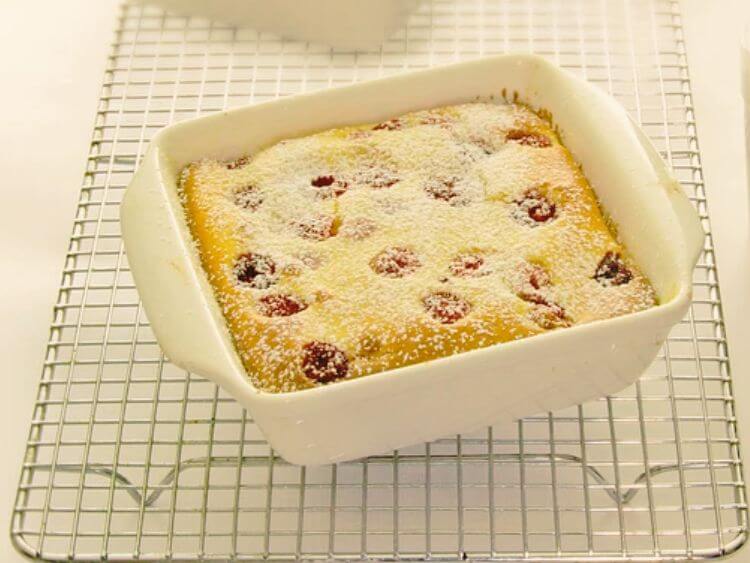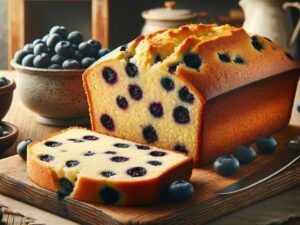Introduction and Basic Understanding
Introduction to the Challenge
Blueberry pound cake is a beloved dessert, but often home bakers encounter the frustrating challenge of blueberries sinking to the bottom of the cake during baking. This aesthetic and textural issue can transform an otherwise delightful treat into a dense, blueberry-studded disappointment.
Understanding the Science Behind Sinking Blueberries
Understanding the science behind blueberry sinking requires delving into the interplay of density, gluten development, and batter viscosity. Blueberries, with their higher density than the batter, tend to gravitate towards the bottom of the pan during baking. Gluten, a protein network formed from wheat flour, plays a crucial role in suspending blueberries throughout the batter. However, overmixing the batter can lead to excessive gluten development, resulting in a denser cake and increased likelihood of blueberry sinking. Batter viscosity, or its thickness, also influences blueberry distribution. A thin batter provides less resistance to blueberry movement, allowing them to settle more easily.
Tackling this baking challenge lies in balancing technique and ingredient selection. Gentle mixing techniques prevent excessive gluten development, while proper ingredient proportions ensure an ideal batter viscosity that suspends blueberries without compromising the cake’s structure. By understanding the underlying principles, bakers can transform blueberry pound cakes from sunken disappointments into evenly distributed masterpieces.
Techniques and Tips
Pre-Baking Preparations
Pre-baking preparations play a vital role in preventing blueberries from sinking in pound cakes. Selecting the right type of blueberries is crucial. Fresh, firm blueberries with a vibrant hue are preferred over mushy or overripe ones. Overripe blueberries tend to burst in the batter, releasing their juices and causing a dense, cake-like texture.
Washing and drying blueberries are essential steps to prevent excess moisture and unwanted flavor transfers. Gently rinse the blueberries under cool running water to remove any dirt or debris. Avoid using hot water, as this can damage their delicate skins. Pat the blueberries dry with clean paper towels or a kitchen towel to remove excess moisture. Wet blueberries can disrupt the batter’s consistency and contribute to blueberry sinking.
Coating Blueberries: Myths and Facts
Coating blueberries with flour is a common misconception often touted as a solution to prevent sinking. However, this technique is ineffective and can even be counterproductive. Flour coating can create a grainy texture and interfere with the cake’s overall flavor and texture. Instead, consider alternative coatings that provide a barrier between the blueberries and the batter, hindering their descent.
Cornstarch and tapioca starch are two effective alternatives. Both starches act as a thin barrier, preventing the blueberries from releasing their juices and weighing down the batter. Additionally, they do not significantly alter the flavor or texture of the cake. To coat blueberries with either starch, gently toss them in a small amount of cornstarch or tapioca starch until evenly coated. A light dusting is sufficient, as too much starch can create a gummy texture.
Batter Consistency and Its Role
Batter consistency plays a crucial role in preventing blueberries from sinking in pound cakes. A thicker batter provides better suspension for the blueberries, hindering their downward movement. Batter thickness is determined by the ratio of wet ingredients to dry ingredients. A higher proportion of dry ingredients results in a thicker batter that can better support the weight of the blueberries.
To achieve optimal batter consistency, carefully follow the recipe’s ingredient proportions. If the batter appears too thin, gradually add a small amount of flour until it reaches the desired consistency. Conversely, if the batter is too thick, gradually add a small amount of liquid until it becomes smooth and pourable.
Remember, even a slight adjustment in batter consistency can significantly impact blueberry distribution. By striking the right balance between wet and dry ingredients, bakers can create a batter that suspends blueberries evenly, resulting in a beautifully textured and aesthetically pleasing pound cake.
Layering Techniques
Layering blueberries is an effective technique for preventing sinking and achieving even distribution throughout the cake. This method involves alternating layers of batter and blueberries, creating a visually appealing and evenly textured cake.
To layer blueberries in a pound cake, follow these steps:
-
Preheat the oven and prepare the pan.
-
Pour half of the batter into the prepared pan.
-
Gently scatter half of the blueberries over the batter, distributing them evenly.
-
Pour the remaining batter over the blueberries, leaving a small gap at the top of the pan to allow for expansion.
-
Gently scatter the remaining blueberries over the top of the batter.
-
Bake the cake according to the recipe instructions.
Layering blueberries not only prevents sinking but also adds a delightful visual element to the cake. As the cake bakes, the blueberries create pockets of color and flavor throughout the pound cake, enhancing its overall appeal.
Related: Blueberry Pound Cake Recipe: A Classic with a Burst of Blueberry, Delightful Heart Cakes: Recipes, Decoration Tips & Celebration Ideas
Oven Temperature and Baking Time
Oven temperature and baking time are crucial factors in preventing blueberry sinking and ensuring an evenly baked pound cake.
Oven Temperature: Maintaining the correct oven temperature is essential for proper batter set and blueberry suspension. An oven that is too hot can cause the batter to rise too quickly, leading to blueberry sinking. Conversely, an oven that is too low will result in an underbaked cake with a dense, gummy texture and increased likelihood of blueberry sinking.
Baking Time: Baking time is directly related to cake size. A smaller cake will bake more quickly than a larger one. Overbaking a smaller cake can lead to dryness and blueberry sinking, while underbaking a larger cake can result in a raw, uncooked center and uneven blueberry distribution.
To ensure optimal baking outcomes, follow the recipe’s instructions for oven temperature and baking time. For a more precise approach, use an oven thermometer to verify the oven’s actual temperature and adjust baking times accordingly. Additionally, use a toothpick or cake tester inserted into the center of the cake to check for doneness. If the toothpick comes out clean, the cake is ready.
Advanced Tips and Tricks
Beyond the fundamental techniques, experienced bakers employ advanced tips and tricks to achieve professional-level blueberry pound cakes with evenly distributed blueberries and exceptional texture. Here are some lesser-known secrets:
-
Chill the Blueberries: Refrigerating blueberries for at least 30 minutes before adding them to the batter helps firm them up, reducing their tendency to sink. Colder blueberries also slow down their release of juices, maintaining the batter’s consistency.
-
Fold Gently: Overmixing the batter can activate gluten development, leading to a denser cake and increased likelihood of blueberry sinking. Instead, fold the blueberries into the batter gently with a spatula, just until they are evenly distributed.
-
Use a Stand Mixer for Controlled Mixing: A stand mixer allows for precise mixing speed control, preventing overmixing and ensuring gentle incorporation of blueberries. If using a handheld mixer, mix at the lowest speed possible.
-
Sift Dry Ingredients: Sifting dry ingredients like flour, baking powder, and baking soda ensures their aeration, resulting in a lighter, more delicate cake with better blueberry suspension. Sifting also eliminates lumps and inconsistencies in the batter.
-
Rest the Batter: Allowing the batter to rest for 15-30 minutes before baking allows the gluten to relax, resulting in a softer, more tender crumb and improved blueberry distribution. During resting, the starches in the flour can also absorb some of the liquid, slightly thickening the batter and further hindering blueberry sinking.
-
Rotate the Pan Halfway Through Baking: Rotating the pan halfway through baking ensures even heat distribution and prevents one side of the cake from browning more than the other. This even baking helps the blueberries settle evenly throughout the cake.
-
Cool the Cake in the Pan: Allowing the cake to cool completely in the pan before inverting it helps it retain its shape and prevents the blueberries from sinking further. The cooling process also allows the cake to set properly, resulting in a better texture.
-
Use a Wire Rack for Cooling: Placing the cooled cake on a wire rack allows air to circulate around it, preventing it from becoming soggy. Wire racks also promote even heat dissipation, ensuring consistent cooling throughout the cake.
FAQs
Q: Can I use frozen blueberries in this recipe?
Yes, you can use frozen blueberries in this recipe. Just make sure to thaw them completely before adding them to the batter. Frozen blueberries may also bleed in the batter a bit more than fresh blueberries, so you may want to toss them with a tablespoon of flour before adding them to the batter.
Q: Can I make this cake without a mixer?
Yes, you can make this cake without a mixer. Just use a wooden spoon or spatula to cream the butter and sugar together, and then whisk in the eggs one at a time. You can also fold in the dry ingredients and blueberries by hand.
Q: Can I substitute different types of sugar for the granulated sugar?
Yes, you can substitute different types of sugar for the granulated sugar in this recipe. Brown sugar, light brown sugar, or coconut sugar would all be good options. Just make sure to adjust the baking time slightly if using a different type of sugar. Brown sugar will add a bit more moisture to the cake, so you may need to reduce the baking time by a few minutes. Coconut sugar will also add a bit of moisture to the cake, and it may also give the cake a slightly caramel-like flavor.
Conclusion
Crafting a blueberry pound cake that showcases evenly distributed blueberries and a delightful texture requires careful attention to technique and ingredient selection. By understanding the science behind blueberry sinking, employing effective pre-baking preparations, and incorporating advanced baking techniques, you can transform your pound cakes from blueberry-studded disappointments into masterpieces of even distribution and exceptional flavor.
Remember, the key to success lies in striking the right balance between batter consistency, blueberry coating, and oven temperature. Gentle mixing techniques, proper ingredient proportions, and precise baking times are essential for achieving the desired results.
As you embark on your blueberry pound cake baking journey, feel free to experiment with different variations and presentation styles. Substitute different types of berries, incorporate unique flavorings, and explore creative plating techniques. Share your baking experiences and discoveries with fellow bakers, and let the joy of blueberry pound cake creations fill your kitchen and beyond.


